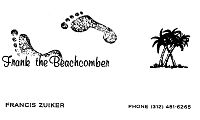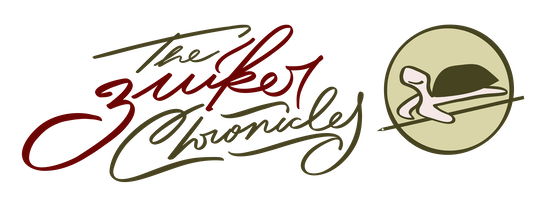Flotsam and jetsam
by Anton Zuiker on November 11, 2025

Frank the Beachcomber, Illinois craft fair, circa 1990.
At antonzuiker.com, my online bio/resume page, there’s one version of my story: magazine writer and editor, Peace Corps Volunteer, Duke communicator and science writer, husband and father and friend.
My 2013 presentation to the University of Chicago communicators about social media is another version. I created that talk in Prezi, a more fluid way (then) to build a narrative than the ubiquitous PowerPoint.
Lately, I’ve wanted to try iA Presenter, another PowerPoint alternative, and at work I needed a way to pull together some branding tips for a project. I realized that my life and career have been awash in brands, so I’m using Presenter to retell my story, and in the process I’m getting to relive – and get new perspective on – what and who inspired my blogging activities.
Grandpa Sisco, I was reminded, was a traveling salesman for McKesson, now the largest health care company in the country. Grandpa Zuiker had been a metalworker at the Pullman Company, at one time the largest hotel in the world, its sleeper cars crisscrossing U.S.A. railways. Grandpa Sisco typed his diary every day and sent it to me, and Granda Zuiker sent his fishing stories. I became a writer and a blogger because of them.
I practiced my presentation with my coach, Troy Livingston.
“One of the things that’s interesting about you,” Troy said when I was done, “is that, what most people don’t do, is you create something.”
In my story, I created the Zuiker Chronicles Online, mistersugar, BlogTogether and ScienceOnline, Talk Story, Voices of Duke Health, and the Long Table.
Notebooks
My morning routine includes meditation, coffee, writing in my diary, and then a few minutes with a book. What I’m reading now is The Notebook: A Brief History of Thinking on Paper, by Roland Allen. I’m slowly making my way through it, but relishing how every chapter is reminding me of some part of my own life in notebooks.
For example, the Introduction tells the modern-day marketing miracle of the Moleskine notebook—I know that brand and its product well. My earliest Moleskine is from 2005, and I used the first page to write a title for what I hoped would follow: Observations. Midway through, on a page dated December 21, 2006, I find Troy’s name and notes on meeting him in his office in the Museum of Life and Science, where he was vice president for innovation and learning. Troy was intrigued by the idea of the North Carolina Science Blogging Conference, an event that I was in the midst of planning. In my branding presentation, I explain how that event grew into the annual ScienceOnline conference and year-round international online community.
And then this, on page 70, about notebooks in the late 1300s called rapiaria:
In these devotional notebooks, the pious collected phrases or ideas from their scriptural reading, and added their own spiritual insights; the act of writing led to further rumination, helping the writer benefit from the wise words they copied.
My mother has done this for at least 70 years, and last year she sent me a binder with copies of her notebook pages showing favorite Bible passages, childhood memories, and dreams she recorded on waking. I read through the binder slowly one afternoon and gained a deeper understanding of her life.
On the beach
After my presentation run through, Troy pointed out that I had referred to my grandfather by his nickname but I hadn’t introduced it clearly enough.
I revised the script: Once my grandfather retired, he kept selling beer at Wrigley Field (Cubs), Comiskey Park (White Sox), Chicago Stadium (Bulls and Blackhawks), and Soldier Field (da Bears). And, he and my grandmother, Clarice, traveled the country with their camper, fishing in the Outer Banks and gathering seashells and fossilized sharks teeth on Florida beaches. In between trips, Grandpa sent typewritten letters and travel stories to his 9 children scattered from coast to coast. He called his letters the Zuiker Chronicles.
 At the craft fairs where he sold necklaces and art made with those seashells, my grandfather passed out business cards identifying himself as Frank the Beachcomber. Amid the pile of his Zuiker Chronicles, I find a typewritten letter to promote his wares.
At the craft fairs where he sold necklaces and art made with those seashells, my grandfather passed out business cards identifying himself as Frank the Beachcomber. Amid the pile of his Zuiker Chronicles, I find a typewritten letter to promote his wares.
BEACH-COMB CRAFT is not crafting with SHELLS. Rather it is more like blending nature with all its gifts. BEACH-COMB CRAFT is a mixture of driftwood, shells, rocks, clay, pods, beads and gem-stones, with a broad mixture of imagination and experience…We have been through five hurricanes, climbed mountains, challenged dangerous deserts, waded floods, and outraced NORTHERS and have wound up with BEACH-CRAFT.
The next morning, my breathing done and coffee cup in hand, I opened The Notebook to read this on page 150:
The son of a fisherman, Coenan lived in Scheveningen, on the North Sea coast, where boats had been drawn up on the wide sandy beach for centuries. The auctioneer at the official fish market in the town, and a licensed beachcomber, he had been in constant contact with marine life for all of his sixty-three years. His Visboek – which is pronounced, and means, ‘fishbook’ – collects his knowledge into a handwritten compendium that shines a light not only on the business of fish but on the Coenan era’s ever-increasing appetite for understanding and order.
What! A Dutchman with a license to collect things at the seashore? I had to know more.
That lead me down a rabbit hole and soon I was reading The Law of Wreck in Flanders, Holland and Zeeland in the Late Middle Ages and I was learning about how the counts and kings called dibs on any jetsam that washed ashore.
I turned to my double-volume New Shorter Oxford English Dictionary to confirm my understanding of jetsam (stuff discarded from a ship or left over from a shipwreck) and to learn that wreckage floating on the sea is called flotsam; stuff that ends up at the bottom of the sea is called lagan. The OED also explains that, at first in the 1800s, beachcomber was “chiefly disparaging” and referred to a “drifter or vagrant who lives, or spends large amounts of time, on the seashore, often scavenging for items to sell or looking to pick up casual employment.”
Those beachcombers, it seems, were sailors who jumped ship and went native in the South Pacific. One hundred and fifty years later, I was living on a South Pacific island and similarly walking the beaches. Thankfully, as my grandfather helped with his Carolina beachcombing, the meaning of the word had shifted to reflect travel and leisure.
Yesterday, I finished reading Allen’s chapter 14 on “travellers and their notebooks, 1470-present.”
In another tattered Moleskine here on my desk, I turn to a page dated March 31, 2014. I was back on St. Croix in the U.S. Virgin Islands, 30 years since I my early teen years there (I used a notebook to record the U.S. Navy ships that tied up to the Frederiksted Pier). I was rediscovering the island, and myself. Ended the day on the beach, combing for seaglass. Splendid live-in-the-moment way to live.
Previous post: Take my ball, go home
Go to HOME

